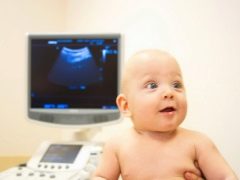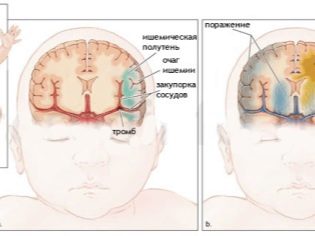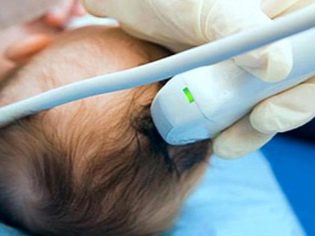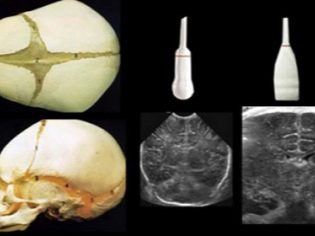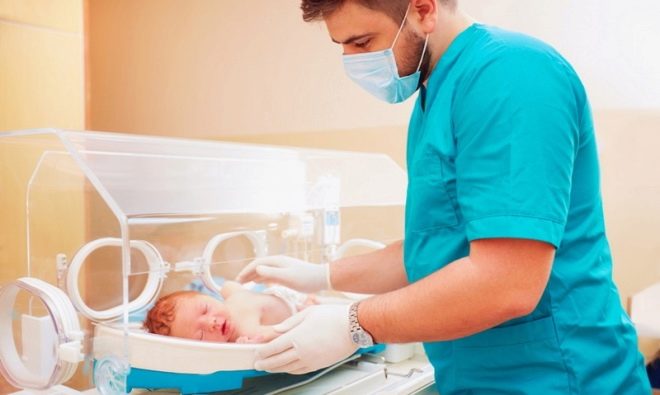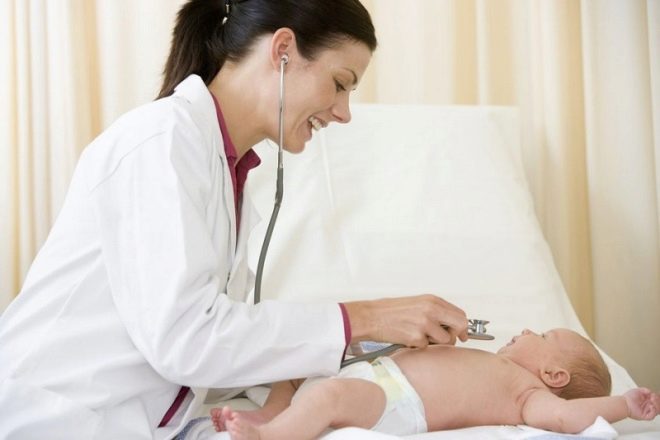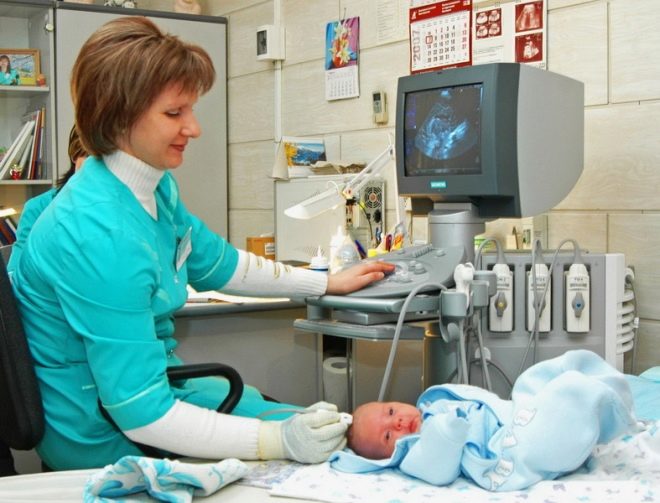Ultrasound of the brain in newborns and infants
A few years ago, ultrasound of the brain in infants and babies was performed strictly according to indications in the presence of complaints and neurological disorders. Now this method of examination is included in the list of mandatory screening studies for all infants, but there are no fewer questions from parents. What kind of examination is it, that it helps to find out what the norms should be and whether it is necessary to make such a diagnosis to a child, does it harm? We will answer all these questions in this article.
What it is?
Ultrasound examination of a karapuz brain is a good and informative way to evaluate how the brain, its membranes, some internal structures and adjacent tissues are developed, to assess the speed and characteristics of the blood flow. This study is called neurosonographic. Neurosonography helps to establish certain abnormalities in the structure of the brain, pathologies, both congenital and acquired in the first days and months of life.
They try to carry out the procedure according to indications in the maternity hospital, without indication - to all children at 1 month during a comprehensive ultrasound examination as part of the first medical examination of the infant. If for some reason the child does not pass inspection in a month, he is recommended to make neurosonography in 2-3 months.
It is possible to pass an examination up to a year, maximum one and a half years After this age, the movable and soft “springs” on the head of the baby are closed and hardened, namely, they give the doctor the opportunity to look into the contents of the skull. When the fountain springs are closed, other methods for examining the brain are assigned, if required - EEG, CT, MRI, etc.
The essence of the method consists in the penetration of high-frequency ultrasonic waves through tissues and liquid media and their ability to reflect and flow back to the sensor. From different tissues, waves are reflected with different intensities, and as a result, an image is formed on the monitor of the ultrasonic scanning equipment. According to the method of research is no different from conventional ultrasound.
Is it safe?
Ultrasound examination of the baby’s brain is considered a completely safe form of diagnosis. It is painless, passes quickly, gives quite complete information about brain structures. The claims of opponents of neurosonography are based on the insufficient knowledge of the effect of ultrasound waves on a newborn. Medicine really does not have sufficient statistics on the possible effects of ultrasound on children and adults in the distant future, because the method began to apply just a little more than two decades ago. But there is also no negative impact data.
Judge for yourself - a pregnant woman in the process of carrying a baby does an ultrasound at least 2-3 times. At the time of prenatal ultrasound, the doctor also assesses the brain structures of the fetus, as far as visualization allows it. Needless to say, the ability to detect pathology is wider not in the prenatal period, when the fetus's brain is separated from the sensor-scanner by water, the abdominal wall of the mother, but after birth, when the baby’s brain is separated from the sensor only by the skin.
Neurosonography, by the decision of the Ministry of Health, included in a comprehensive screening study to all the kids by chance. The fact is that the number of detected brain pathologies is growing, and quite often it is possible to identify them only at a later age.The earlier an anomaly is detected, the more chances to provide the child with the necessary help, treatment, correction.
MRI and CT, which are carried out with the use of anesthesia for babies, because they require a long stay in immobility, are more harmful than ultrasound, and they will have to be done if they reveal pathology after the spring on the baby's head is closed.
Indications
Neurosonography, as already mentioned, is recommended today for everyone. Parents may refuse to diagnose, because the order of the Ministry of Health is advisory in nature. But before you refuse, it is worthwhile to think well, and whether your baby belongs to the risk group for the development of brain pathologies.
NSG is especially indicated for premature babies. If a child is born ahead of time, he needs not only a single examination, but also an ultrasound of the brain in dynamics - it is very important to know how the main organ of the central nervous system of the baby develops. Also, an ultrasound scan of the head is recommended for children born due to the coordinated work of the surgical team that made the Cesarean section to the mother.
In addition, examination is recommended for children who were born after a severe pregnancy, accompanied by fetal hypoxia, threatened abortion, problems with uteroplacental blood flow. Other indications for neurosonography are:
- low birth weight (if a crumb appeared with a weight of less than 2.7 kilograms);
- if the child at birth received 7/7 apgar, and below these values;
- unusual behavior of the newborn and the baby (the baby sucks weakly, often and abundantly belches, cries for a long time, sleeps uneasily, often wakes up, trembling of the limbs, chin, squint is pronounced);
- impaired hearing and visual function;
- presence of external malformations - additional fingers on the hands or feet, asymmetrical ears, lack of body parts;
- low level of blood pressure in a child, cases of loss of consciousness;
- cramps in a child;
- falls, injuries at which there were head blows or sharp droppings of a head;
- birth injury.
Neurosonography is prescribed before surgery on the heart and blood vessels, before surgery on the brain. After suffering a severe viral infection, it is also recommended that an NSS be made to an infant to eliminate inflammatory processes in the membranes and brain structures, such as meningitis, encephalitis, meningoencephalitis.
NSG shows tumors, cysts, signs of hypoxia, if the child has experienced it during fetal development or during childbirth.
A baby who did not scream in time at the birth hall, which was born as a result of protracted or fast labor, with the presence of Rh-conflict, must have been examined methods of NSG.
Ultrasound of the brain to a child up to one year may be required in order to confirm or exclude hydrocephalus, a number of neurological disorders, as well as to verify the effectiveness or absence of the effect of the prescribed treatment.
Despite all the advantages and advantages of the examination method, it cannot be considered as 100%, like any ultrasound examination. The diagnosis is not established solely on the basis of a neurosonographic conclusion. If a certain pathology is suspected, then the child is scheduled for additional research by other methods, for example, MRI or CT.
How is it done?
Neurosonography in newborns and infants is carried out by a quite traditional ultrasound method. The child is placed on the couch or in the arms of the mother if he is awake and shows signs of anxiety. The sensor examines the structure of the brain, the result of the survey is made out in the form of an ultrasound protocol (neurosonographic examination protocol).
The study lasts no more than 7-10 minutes. Ideally, if the baby is going to sleep at this time, but even if the little ones are awake, they will still be tested, the activity of the baby does not affect the results of the diagnosis.
Additionally, a blood flow study can be conducted, in which case the doctor will need to examine the baby’s head and neck with a doppler sensor. For infants, NSG with doppler is also a harmless and painless diagnostic method.
Training
No separate training is required. You do not need to restrict the baby to eat, on the contrary, it is better to feed him before the examination so that he is calmer.
If a child is prescribed any medications, it is necessary to inform the doctor about this. If possible, the baby is taken off antispasmodic drugs before the test is completed a couple of days to eliminate the effect of these drugs on the vessels. If there is no possibility to cancel the prescribed medication, the doctor simply takes into account which drug and in which dosage the child takes. Be sure to inform the specialist.
Results and norms
All that shows neurosonographic research, detailed in the conclusion. Decryption of this conclusion - the task of specialists. The norm of values is presented in the table, which is used by all pediatric neurologists.
If we talk about the norm in general terms, then in a healthy child all parts of the brain are well visualized, the grooves and gyrus are visible, both hemispheres are symmetrical. But if a child has a fluid in the hemispheric space or is talking about the presence of a cyst, this does not mean that the baby has serious deviations. Some of the “findings” of neurosonography are quite natural, for example, for premature babies or babies who have experienced acute hypoxia during childbirth.
On the numerical values specified in the conclusion, you can not pay special attention if it indicates that the child is healthy. In the course of diagnostics, each of the brain areas is looked at and measured, but a separate excess or reduction in size from the norm does not mean anything. Only a combination of factors that a specialist evaluates can speak of signs of hypoxia, angiopathy, hydrocephalus, or other pathologies.
Opinion of Dr. Komarovsky
The famous pediatrician Yevgeny Komarovsky fully supports the decision of the Ministry of Health to make neurosonography ubiquitous and universal. Her undoubted plus, according to Evgeny Olegovich, is the ability to detect congenital brain pathologies in children as soon as possible. But no less significant minus the widespread NSG, says Komarovsky, is that the ultrasound does one doctor, and the treatment is completely different. Thus, a child’s diagnosis is often made only on the basis of an ultrasound scan, without comparison with real symptoms.
Again, there is overdiagnosis. The brain of a newborn is different from the adult brain, and therefore certain extensions, echogenicity and other scary words and signs are found in 100% of children, which gives doctors the opportunity to prescribe a long list of drugs that have no special actions, but have a high price. The fact that the pseudocysts and a number of other "finds" safely pass to the year themselves, of course, are not reported to parents.
Do I need to do this survey? Evgeny Komarovsky is sure that it is necessary. It is necessary to eliminate the true anomaly as early as possible.
Reviews
According to reviews of mothers, doctors rarely explain the need for this type of ultrasound for a child, and therefore it would seem like a completely healthy baby to receive directions for neurosonography from parents to a lot of questions and conjectures. On the forums, they can read other reviews, that such an ultrasound is extremely harmful, dangerous and useless.
To do or not - only the parents decide. If there is a desire to refuse, be sure to read about the consequences of neglected brain pathologies.They can be quite unpleasant and disastrous.
For information on whether to conduct ultrasound of the brain to children of the first year of life, see the following video.
